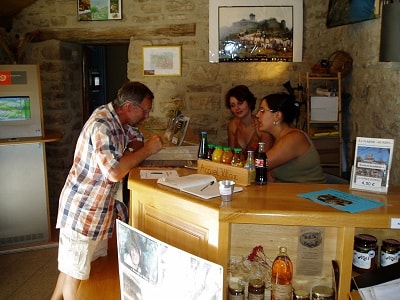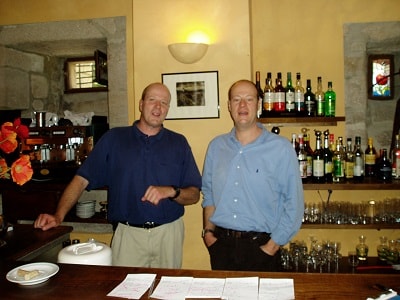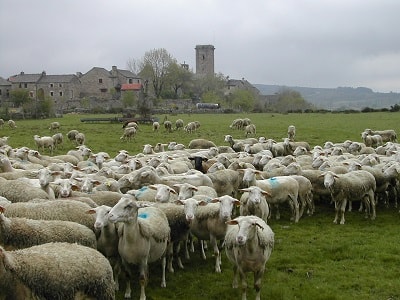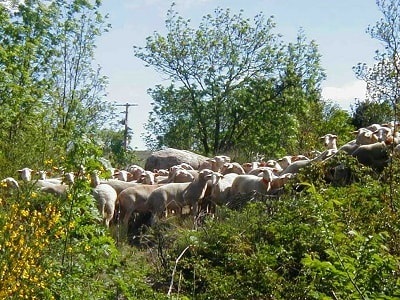

 The population of the village, a hamlet in the municipality of Prevencheres, has varied significantly over the centuries. In 1789, there were 111 inhabitants; by 1846, the number had increased to 158; in 1936, it decreased to 84; and by 1980, only 12 remained. The school, which had 35 students in 1930, had to close in 1963, as only 3 students were left. In 1880, two schools were open in La Garde: a private school and a public school.
The population of the village, a hamlet in the municipality of Prevencheres, has varied significantly over the centuries. In 1789, there were 111 inhabitants; by 1846, the number had increased to 158; in 1936, it decreased to 84; and by 1980, only 12 remained. The school, which had 35 students in 1930, had to close in 1963, as only 3 students were left. In 1880, two schools were open in La Garde: a private school and a public school.
Today, 15 residents live there year-round, most of whom are retirees. During the summer period, if we include the people staying at Auberge Regordane, the population is larger, totaling around a hundred people.
 Since 1972, many houses have indeed been restored or are in the process of being restored by families who have been residing there for several generations or by individuals who have purchased a house.
Since 1972, many houses have indeed been restored or are in the process of being restored by families who have been residing there for several generations or by individuals who have purchased a house.
One of the primary resources for the village inhabitants has long been the chestnut. The lands were cultivated up to the banks of the Chassezac river. Chestnut trees were also planted in the best-sheltered parts of the plateau and on the slopes of the Pourcharesses side. On the gorge slopes, you’ll find chestnut groves established in small terraced gardens called “accols”, supported by dry stone walls built by local men. These “accols” were irrigated through channels that brought water from the Chassezac.
Every family owned one or more chestnut dryers, known as “Cledes”, either on a gorge slope or in the village. As the population decreased, the more remote and less mechanizable lands were abandoned.
Livestock farming remains another resource for the village today. Between 1950 and 1960, there were 1,000 sheep, 50 cows, 100 goats, 1 or 2 pigs, and poultry in each house (about twenty). Not to forget the working animal, most often a mule, sometimes a horse or a donkey. A communal shepherd tended to the herd and was fed in turn by each owner, based on the number of animals or “days” they had in the flock.
 A fair was held in La Garde-Guerin on Saint Michael’s Day, September 29, and has been a tradition since the 14th century. The last fair took place in September 1938. This fair was intended for the ‘shepherds’ lodge.’ On that day, shepherds from the entire neighborhood found work, as did chestnut pickers and those who went to clean the chestnut groves. The elders speak of it as a festive event. The ‘Pre de la Foire’ (Fair Meadow) welcomed all sorts of merchants and showmen who, due to the slowness and scarcity of transportation in that era, arrived in the village two or three days before and stayed with the locals.
A fair was held in La Garde-Guerin on Saint Michael’s Day, September 29, and has been a tradition since the 14th century. The last fair took place in September 1938. This fair was intended for the ‘shepherds’ lodge.’ On that day, shepherds from the entire neighborhood found work, as did chestnut pickers and those who went to clean the chestnut groves. The elders speak of it as a festive event. The ‘Pre de la Foire’ (Fair Meadow) welcomed all sorts of merchants and showmen who, due to the slowness and scarcity of transportation in that era, arrived in the village two or three days before and stayed with the locals.
The villagers lived self-sufficiently. They had their vegetable gardens, and the meat consumed was from the animals they raised: pigs and poultry. Potatoes, along with chestnuts, were the main staple, cultivated in the fields. Bread was baked in the communal oven, known as the ‘banal’ or village oven. Each family took turns using it. This practice continued until 1966. The bread was made from locally grown cereals (wheat and rye), harvested and brought to the mill.
 All of this explains how people managed, not without difficulties, to feed large families (with 6 to 16 children). They bought coffee, wine, oil for salads, and lard served as the cooking fat. Today’s economy mainly relies on sheep and rye. It is practically the sole crop at present, and it is intended for animal feed. This fragile economy is sustained by two breeders who are determined to benefit the village throughout the year.
All of this explains how people managed, not without difficulties, to feed large families (with 6 to 16 children). They bought coffee, wine, oil for salads, and lard served as the cooking fat. Today’s economy mainly relies on sheep and rye. It is practically the sole crop at present, and it is intended for animal feed. This fragile economy is sustained by two breeders who are determined to benefit the village throughout the year.
For the past twenty years, the Hotel Regordane has successfully welcomed locals and passersby during the beautiful season. You’ll also find an exhibition of painting, engraving, textile creation, form, and color at the former school workshop in La Garde-Guerin, hosted by Mr. and Mrs. Thibeaux.
As the heir to a prestigious heritage, La Garde-Guerin sees thousands of visitors each year, impressed by the beauty and grandeur of the site. May this village continue to thrive and welcome all those who pass through one of these historic places with a secret! Due to its geology, the water supply to this site has always been problematic: the shallow layer of Triassic sandstone does not allow for sufficient water storage and projection in contact with the underlying granite.
Within the walls of La Garde-Guerin, the wells were often polluted, especially in summer. During this season or in times of siege, the castle cistern, dug directly into the rock at great depth, took over. A precious resource in the Middle Ages, rainwater was subject to a fee paid by the lords. Away from the village, the fountains were of great importance due to their flow rate and water quality until the installation of a potable water supply in 1938."
***
 In the 12th century, in the rugged and wild landscapes of the Occitanie region, the fortified village of La Garde-Guerin proudly stood on the edge of the Chassezac River. This strategic location was crossed by the Chemin de Regordane (GR700), an essential communication route connecting the Massif Central to the Mediterranean. Picture the banks of the Chassezac, the stone ramparts, and the shepherds going about their daily tasks.
In the 12th century, in the rugged and wild landscapes of the Occitanie region, the fortified village of La Garde-Guerin proudly stood on the edge of the Chassezac River. This strategic location was crossed by the Chemin de Regordane (GR700), an essential communication route connecting the Massif Central to the Mediterranean. Picture the banks of the Chassezac, the stone ramparts, and the shepherds going about their daily tasks.
These shepherds, both men and women, were recurring figures in medieval literature. They watched over their flocks of sheep, guiding the animals along rocky and verdant paths. Their days were marked by the tinkling of bells and the gentle bleating of lambs.
 The Regordane Way was much more than a simple pastoral route. It was the vital link between Auvergne, Velay, Languedoc, and the Mediterranean. The shepherds of La Garde-Guerin played a crucial role in ensuring the safety of travelers and goods along this path. They were the guardians of the Regordane, protecting caravans laden with precious goods, colorful fabrics, and exotic spices.
The Regordane Way was much more than a simple pastoral route. It was the vital link between Auvergne, Velay, Languedoc, and the Mediterranean. The shepherds of La Garde-Guerin played a crucial role in ensuring the safety of travelers and goods along this path. They were the guardians of the Regordane, protecting caravans laden with precious goods, colorful fabrics, and exotic spices.
Each shepherd was associated with a “parerie”, a section of the road they meticulously maintained. They collected tolls, enforced grain measurement standards (cartelage), and even had rights over the dust kicked up by their herds. These shepherd knights, known as “los Pariers”, swore allegiance to the Bishop of Mende and formed a robust economic and military community.
The fortified village of La Garde, or “castrum de La Garde”, served as their frontier outpost. They kept watch day and night, scanning the horizon for any danger. Their names echoed in the winds of the Chassezac: the Gaucelmes, the Herail, the Bertrand, and the Gaules. Each clan had its share of responsibility, its parerie to protect.
And so, in the heart of the Middle Ages, the shepherds of La Garde-Guerin wove connections between mountains and sea, stars and herds. Their stories intertwined with those of travelers, merchants, and troubadours. As the sun set behind the ramparts, they gathered around the fire, sharing legends and dreams—guardians of a world in motion. Even today, the stones of La Garde-Guerin carry echoes of their footsteps, and the shepherds of the past watch over our memories like stars in the medieval night.
Old romantic Hotel, L'Etoile Guest-House is a mountain retreat in the South of France. With a beautiful park along the Allier River, L'Etoile Guesthouse is located in La Bastide-Puylaurent between Lozere, Ardeche and Cevennes. Many hiking trails like GR®7, GR®70 Stevenson trail, GR®72, GR®700 Regordane way, Cevenol, GR®470 Allier river, Margeride. Many hiking loops. The right place to relax.
Copyright©gr-infos.com